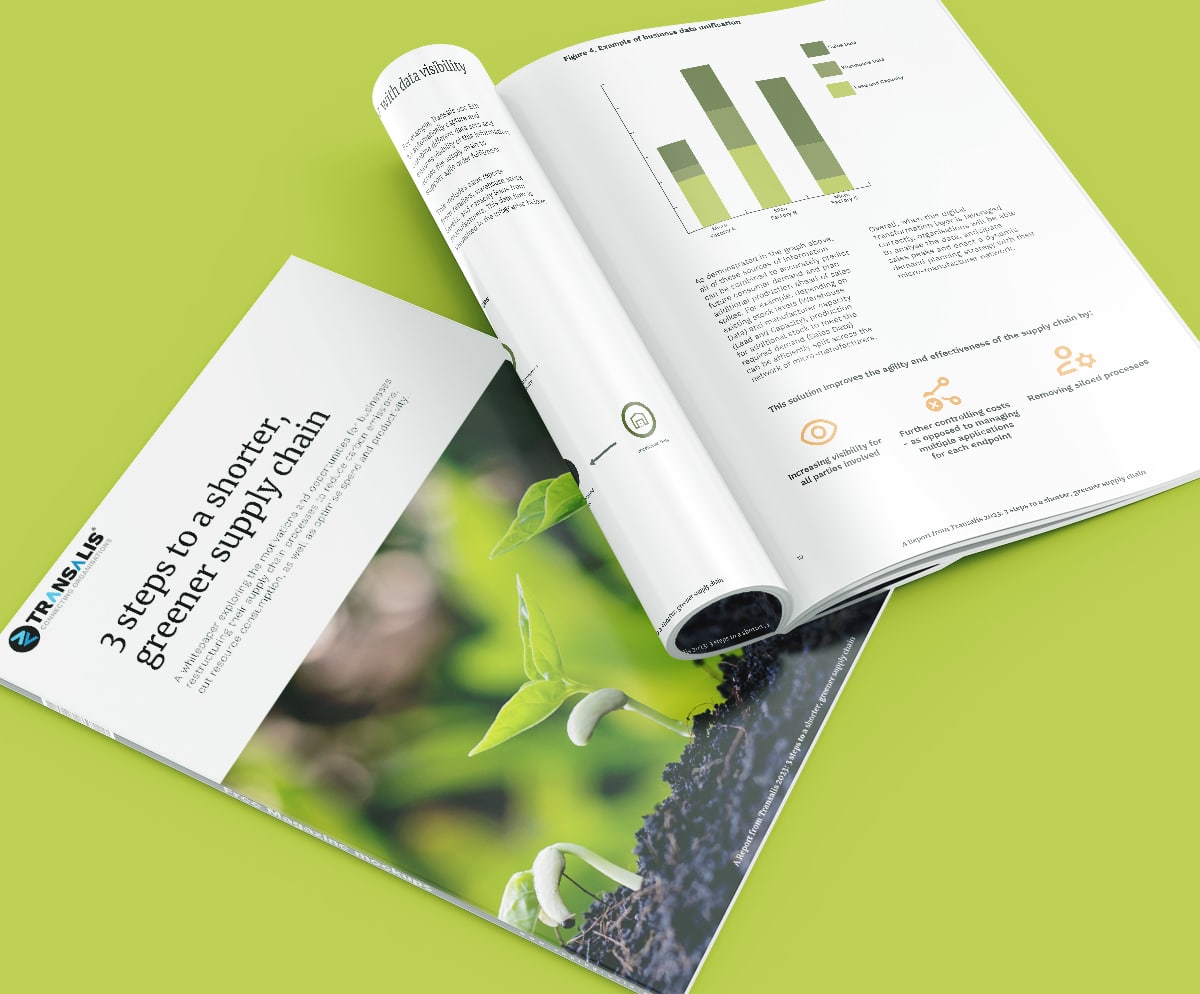
Reducing business carbon emissions, such as eliminating paper consumption, has become a prerequisite in recent years.
As outlined in a report by Forrester, 58% of European consumers prefer to purchase more environmentally friendly products.* Therefore, striving for zero carbon business must be a priority as part of any Corporate Social Responsibility (CSR) strategy. This relates to all aspects of an organisation’s operations; from internal processes, such as production, to external processes, such as those in the supply chain.
3 steps to a greener supply chain report
Get your copy of our latest whitepaper report which details creative strategies to transform business supply chains to be more productive, cost effective, and better for the environment.

Whilst the need for change is accepted, many organisations’ challenge is how to implement environmentally friendly business processes in a timely and cost-effective way. However, contrary to popular belief, there are actually significant commercial benefits to having a green supply chain. Switching from manual processes, for example, is not only more efficient but can also lead to an increased market share. This is because organisations that address their business carbon footprint have greater sustainability credentials to market to potential customers.
This blog, which also forms one chapter of our report; 3 steps to a shorter, greener supply chain, explains how eliminating paper consumption across the supply chain is essential for increased productivity and profitability.
Supply chain strategies to reduce business carbon emissions
As summarised above, one area that businesses can focus on for greater sustainability credentials is digitising the supply chain.
The environmental and commercial cost of paper processing
Paper processing is both costly and time-consuming for any business. Office paper consumption statistics provided in recent research by Adobe, which surveyed over 1500 employees in large organisations, showed that on average each employee prints approximately 450 pages per week.** Overall, this paper and print consumption equates to:
Figure 1. Average annual printed paper consumption per employee
| Pages Printed | REAMS OF PAPER | BOXES OF PAPER | TOTAL PAPER COST |
|---|---|---|---|
| 23,400 | 47 | 5 | £200 |
(based on an average cost for a box of paper – 10 reams, of £40)
When these calculations are scaled up across the whole organisation, or even just across an entire team, the cost implications just for paper consumption are clear. This is not even considering the associated costs of ink and the running costs of printing hardware. Gartner estimates that overall printing costs businesses between 1-3% of their annual revenue.***
There are also the overhead costs to process all these paper documents. In fact, Adobe also found that employees are wasting more than 28 days per year on low-value tasks such as printing, stapling, signing and scanning documents.
In addition to the costs of printing physical paper documents, other costs are associated with a supply chain that runs on outdated processes. As our Customer Service Director explains:
In a traditional, i.e. more manual-based, supply chain you quite conceivably need a team of at least 20 people on-premise to deliver on the full order cycle successfully. Starting with the retailer buyer raising an order on their system, through the exchange of emailed PDF documentation involving order processing, warehouse and finance teams - taking significant time and resource, without considering the introduction of multiple Single Points of Failure (SPOFs) and opportunities for human error.
The workflow described above is a stripped-back version of common manual supply chain processes and is only reflective of everything running smoothly. When factoring in document mis-keys, communication errors, or other delays, this becomes far more inefficient in cost, consumption and emissions.
Particularly when considering the peripheral ‘costs’ (environmental and financial) for suppliers taking this order management approach, summarised below:
Physical servers that have the capacity to store the required information even at peak periods
Energy usage to run them 24/7
Energy usage of ventilation systems to keep them cool
On-premise teams
Number of overheads
Commuting emissions
On-site energy usage (computer equipment and other hardware, heating, lighting etc.)
On-site office consumables (e.g. paper)

Automate manual processes for environmentally sustainable business
In contrast, businesses that take a digital transformation approach make significant savings in paper consumption, other raw materials and the associated costs. Additionally, enabling EDI and other business automation technologies to manage a supply chain network provides flexibility, scalability and reduces the error rate.
So for organisations wanting to take steps to automate a manual process, where do they start? Well, this can be achieved by onboarding a supply chain technology provider that can facilitate the automated exchange of vital order documentation between trading parties. We recommend scoping out providers that have sustainability credentials to further support your green business objectives.
For example, Transalis works with its technology partners to:
Optimise the energy efficiency of its infrastructure
Reduce physical hardware through server virtualisation
Support the Corporate Social Responsibility of its clients
All of the above contributes to happier consumers, who seek environmentally friendly products. It also contributes to greater business efficiency. This is due to the elimination of manual processes, resulting in increased accuracy and immediacy of data communication.
Reducing business paper consumption and carbon emissions in practice
As outlined above, addressing paper consumption with digital transformation is increasingly common, especially for an organisation committed to becoming a zero carbon company. Transalis has first-hand experience in supporting our clients with these objectives.
We have some key examples of companies reducing carbon footprint, as detailed in our published client case studies. For two clients in particular, (one being Smeg and the other an office supplies business) Transalis automation solutions helped to significantly cut paper consumption.

The main area of focus for these client projects was to digitally transform their manual order processing in a sustainable and scalable way. Smeg were initially printing between 600-800 order documents per month and the office supplies business were printing approximately 2,000 order documents per month.
With our solution, we digitised this documentation for both of these clients as well as automated their processing workflows, using a combination of EDI, narrow AI and integration services.
With this paper-to-digital approach, paper consumption is significantly diminished, errors are eradicated, overheads are reduced, and emissions are cut. Here’s how:
At Transalis, we can innovatively take advantage of server virtualisation. Traditionally, organisations need to acquire servers that can deal with the maximum peak workload during periodic sales spikes. However, with this approach, the organisation is footing the bill for these servers to run on the exact same power and capacity during quieter sales periods. For businesses with seasonal sales peaks, this is not an efficient use of resources. In contrast, server virtualisation allows for the automated scale-up and down of this server capacity depending on demand, thus reducing unnecessary energy consumption year-round. In addition, switching from a manual order processing workflow to one supported by EDI means there are only two human touchpoints; the first at the pick, pack & dispatch stage on the supplier side and the other by scanning the received goods on the retailer side. All other interactions and exchanges of information between parties are entirely automated.
Subject to some controls and forward planning, with EDI in place, a huge number of people are removed from low-value processing in the supply chain. Not only that, but this approach further supports work-from-home or multi-location teams that can access all of this information via the organisation’s internal systems remotely. Overall, this automated workflow significantly cuts business spend and is incredibly important for companies that are reducing their carbon footprint.
As a SaaS business, Transalis takes its environmental responsibilities very seriously. We can help support your organisation meet its CSR and consumer demands. We work with our technology partners to optimise the energy efficiency of our infrastructure, maximise the use of renewable energy and minimise the need for physical hardware through server virtualisation.
eDI Software
If you fancy talking about how automation can cut paper consumption and reduce the company carbon footprint, then get in touch: 0845 123 3746 (UK callers) or +44 1978 369 343 (international callers), or email sales@transalis.com. And in the meantime, why not take advantage of our free resources in our Knowledge Hub where you will find our latest whitepaper reports, case studies and educational blog content.
References:
*Forrester. 2022. European Predictions 2023: Highlights.
**Adobe. 2022. Time, money and environmental impact: the true cost of unsustainable working.
***Gartner. 2019. Forecast: Enterprise Print Spending, Worldwide, 2017-2023, 3Q19 Update.











